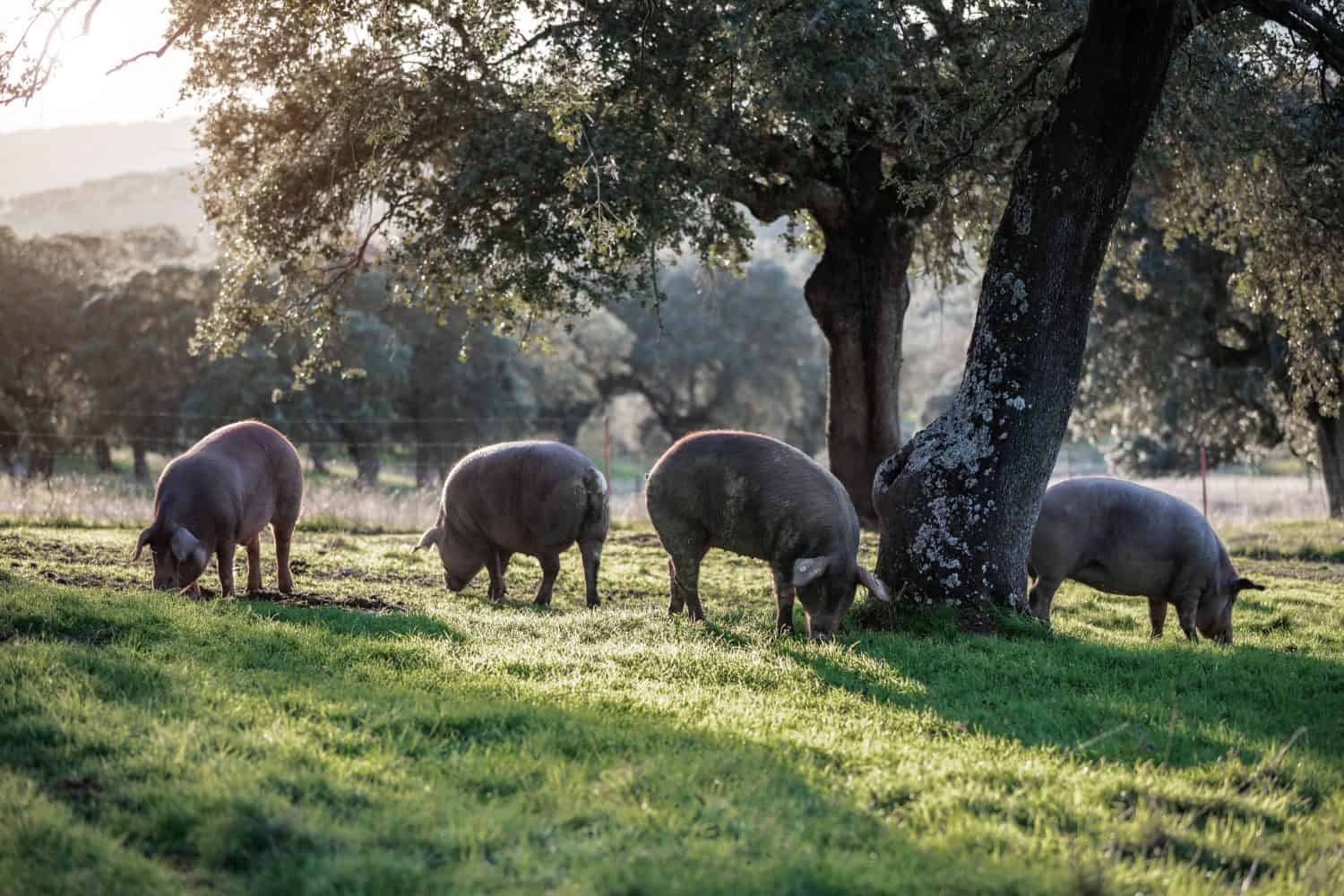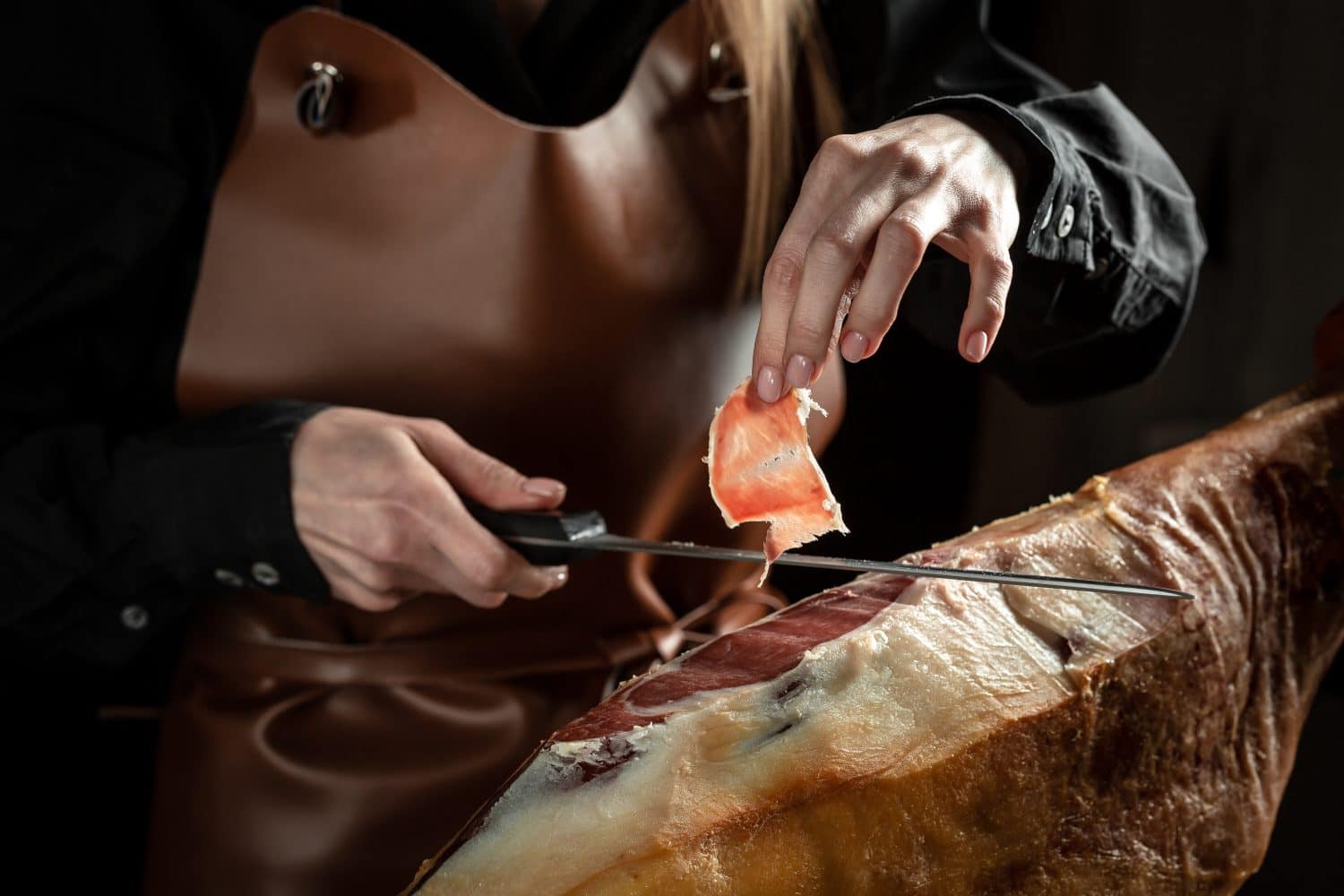When you think of the world’s most expensive foods, you might picture delicacies like caviar and Kobe beef. Ham, on the other hand, probably doesn’t come to mind. However, one of the most expensive foods in the world is a cut of pork from pigs living charmed lives in the Iberian peninsula. Let’s dive into the prices you can expect to pay for Iberian ham in 2024 and why this cut of meat is so expensive.
Iberian Ham is the Most Expensive Ham in the World
Iberian ham (properly known as Jamón Ibérico de Bellota or pata negra) is one of the most expensive foods in the world. This delicious cut of meat commonly sells for $1,000 per leg, but prices can get much much higher.
For example, in 2018 the BBC highlighted a tiny farm in southwestern Spain owned by Eduardo Donato. Donato purchased 10 pigs that were a rare spotted variety of the Iberian breed in 1995. He decided to breed these animals and raise them organically — a rare practice at the time.
Years later Donato had a product that sold for a whopping €4,100 (almost $4,500) per leg. It appears that even this record has since been surpassed by Taishi Co., Ltd. The company sold an Iberian Bellota ham retailing at €11,881.3($13,183.1), according to the Guinness Book of World Records.

Iberian ham comes from organically raised Iberian pigs that graze on grass and acorns. It takes a long time for these pigs to grow large enough to be slaughtered.
©sergio victor vega/Shutterstock.com
Why is Iberian Ham So Expensive?
There are a number of reasons Iberian ham is so expensive. First, true 100% Jamón Ibérico de Bellota comes from purebred pigs native to the Iberian peninsula. These animals are not given growth hormones or fattened with industrial corn.
Instead, they are allowed to graze freely on mostly acorns and grass. For this reason, Iberian pigs grow slower than industrial pigs. According to Campo Grande, it commonly takes Iberian pigs double the time that it takes industrial pigs to reach their ideal slaughter weight.
Once the pigs are ready for slaughter, the process is far from over. True Iberian ham comes only from the pigs’ hind legs. The cut of meat is then salt-cured in a process that takes at least twelve months but can last up to 48 months.
Additionally, authentic Iberian ham is hand-carved and sliced incredibly thin. Professional carvers know that the cut of ham will have a different flavor depending on where on the leg it is sliced. This careful process only adds to the allure and high price of Iberian ham.

True 100% Jamón Ibérico de Bellota is hand sliced. Professional carvers know how each cut of the meat will taste.
©sweet marshmallow/Shutterstock.com
Taste
Iberian ham has an incredible flavor that makes its high price point worthwhile. When sliced properly the cut of meat should be so thin that the fat practically melts in your mouth, with a rich, nutty, and smokey flavor to the meat.
The taste may also vary depending on what part of the leg the meat is sliced. For example, the BBC states that fattier cuts from near the hip have a rich, buttery taste, while drier cuts from closer to the hoove will have a sweet, nutty flavor.
Iberian ham should be served at room temperature. It pairs well with bubbly wines and Spanish cheeses like Manchego. You can also simply enjoy Iberian ham on a piece of freshly sliced bread.
How to Purchase Iberian Ham
As this article details, the price of a leg of Iberian ham depends on several factors. Sliced and packaged Iberian ham may be available at your local Costco or Whole Foods, or even for shipping from Amazon. However, if you’re intent on trying real 100% Jamón Ibérico de Bellota there are a few factors you should keep an eye on.
For example, look for the words “100% Ibérico” on your package of sliced ham. If the product doesn’t say this, it’s possible that it comes from mixed breeds of pigs, rather than pure-bred pigs native to the Iberian peninsula.
Additionally, authentic Iberian ham is hand-carved. That’s not to say that machine-sliced varieties won’t taste amazing. However, the process usually involves deboning and pressuring the leg into a rectangular block, which can change the complexities and texture of the product, according to The Iberico Club.
Finally, true Iberian ham comes from the pig’s hind leg. Paleta, or paletilla, refers to a cut of meat from the pig’s front leg. And while paleta may be delicious, it’s not the same as hand-carved Jamón 100% Ibérico de Bellota.
The photo featured at the top of this post is © farinasfoto/Shutterstock.com
Thank you for reading! Have some feedback for us? Contact the AZ Animals editorial team.







